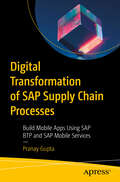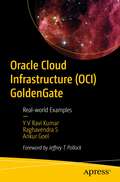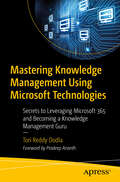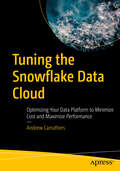- Table View
- List View
Digital Transformation of SAP Supply Chain Processes: Build Mobile Apps Using SAP BTP and SAP Mobile Services
by Pranay GuptaTake a high-level tour of SAP oDATA integrations with frontend technologies like Angular using the SAP Mobile Services Platform. This book will give you a different perspective on executing SAP transactions on iOS using Angular instead of SAP-provided Fiori-based applications. You’ll start by learning about SAP supply chain processes such as Goods Receipt, Transfer Posting, Goods Issue, and Inventory Search. You’ll then move on to understanding the thought process involved in integrating SAP's backend (SAP ECC) with Angular iOS app using SAP Mobile Services running on SAP BTP. All this will serve as a guide tailored to SAP functional and technical consultants actively engaged in client-facing roles. You’ll follow a roadmap for modernizing and streamlining supply chain operations by leveraging Angular iOS apps. Digital Transformation of SAP Supply Chain Processes provides the essential tools for businesses looking to stay competitive in today's technology-driven landscape. What You Will Learn Study the fundamental procedures to set up the Authorization Endpoint, Token Endpoint, and base URL within SAP Mobile Services.Manage attachments in mobile applications and store them in an external content repository. Gain proficiency in testing OData services using the POSTMAN API client with OAuth protocol.Acquire knowledge about the JSON messages, CORS protocol, and X-CSRF token exchange.Link Zebra Printers through the Zebra Native Printing app on iOS App to print SAP forms on mobile printers. Who This Book Is For SAP Consultants with an interest in the Digital Transformation of SAP Supply Chain Processes to iOS-based SAP transactions.
CodeMosaic: Learn AI-Driven Development and Modern Best Practices for Enterprise
by Arpit DwivediThis book is a comprehensive guide for those navigating through the complexities of enterprise software development. For fresh graduates, transitioning from college projects to real-world applications can be overwhelming. This book acts as a roadmap, helping you bridge the gap to become industry-ready. It's like an intensive internship in book form, equipping readers with the skills and knowledge needed for modern tech roles. But it's not just for newcomers. Even experienced developers can get caught up in old routines and miss out on new tools and techniques. With the rise of AI and automation tools like ChatGPT and Copilot, the development landscape is rapidly changing. The core of the book revolves around practical application. Using .NET, Angular, and other Microsoft technologies as foundational pillars, you’ll embark on a hands-on journey. From understanding the basics to designing and deploying a full-stack web application, CodeMosaic offers a holistic learning experience. By the end, you won't just be a developer; you'll be well-equipped to tackle the challenges of today's digital world. What You'll Learn Review Agile methodologies and Azure DevOps for streamlined project management. Gain a thorough understanding of smart development from design to deployment. Master software development with .NET and Angular, along with effective version control using Git. Enhance your coding and design skills using GitHub Copilot, GPT technologies, and AI-driven prompt engineering. Who This Book Is For Experienced developers looking for new tools and techniques, and recent graduates, transitioning from college projects to real-world applications.
Understanding Generative AI Business Applications: A Guide to Technical Principles and Real-World Applications
by Irena CroninThis guide covers the fundamental technical principles and various business applications of Generative AI for planning, developing, and evaluating AI-driven products. It equips you with the knowledge you need to harness the potential of Generative AI for enhancing business creativity and productivity.The book is organized into three sections: text-based, senses-based, and rationale-based. Each section provides an in-depth exploration of the specific methods and applications of Generative AI. In the text-based section, you will find detailed discussions on designing algorithms to automate and enhance written communication, including insights into the technical aspects of transformer-based Natural Language Processing (NLP) and chatbot architecture, such as GPT-4, Claude 2, Google Bard, and others. The senses-based section offers a glimpse into the algorithms and data structures that underpin visual, auditory, and multisensory experiences, including NeRF, 3D Gaussian Splatting,Stable Diffusion, AR and VR technologies, and more. The rationale-based section illuminates the decision-making capabilities of AI, with a focus on machine learning and data analytics techniques that empower applications such as simulation models, agents, and autonomous systems.In summary, this book serves as a guide for those seeking to navigate the dynamic landscape of Generative AI. Whether you’re a seasoned AI professional or a business leader looking to harness the power of creative automation, these pages offer a roadmap to leverage Generative AI for your organization’s success.What You Will LearnWhat are the technical elements that constitute the makeup of Generative AI products?What are the practical applications of Generative AI?How can algorithms be designed to automate and improve written communication?What are the latest Generative AI architectures and algorithms?Who This Book Is ForData scientists, data analysts, decision makers, and business executives interested in gaining an understanding of Generative AI products
Software Development, Design, and Coding: With Patterns, Debugging, Unit Testing, and Refactoring
by John F. Dooley Vera A. KazakovaLearn the principles of good software design and then turn those principles into great code. This book introduces you to software engineering — from the application of engineering principles to the development of software. You'll see how to run a software development project, examine the different phases of a project, and learn how to design and implement programs that solve specific problems. This book is also about code construction — how to write great programs and make them work. This new third edition is revamped to reflect significant changes in the software development landscape with updated design and coding examples and figures. Extreme programming takes a backseat, making way for expanded coverage of the most crucial agile methodologies today: Scrum, Lean Software Development, Kanban, and Dark Scrum. Agile principles are revised to explore further functionalities of requirement gathering. The authors venture beyond imperative and object-oriented languages, exploring the realm of scripting languages in an expanded chapter on Code Construction. The Project Management Essentials chapter has been revamped and expanded to incorporate "SoftAware Development” to discuss the crucial interpersonal nature of joint software creation. Whether you're new to programming or have written hundreds of applications, in this book you'll re-examine what you already do, and you'll investigate ways to improve. Using the Java language, you'll look deeply into coding standards, debugging, unit testing, modularity, and other characteristics of good programs. You Will Learn Modern agile methodologies How to work on and with development teams How to leverage the capabilities of modern computer systems with parallel programming How to work with design patterns to exploit application development best practices How to use modern tools for development, collaboration, and source code controls Who This Book Is For Early career software developers, or upper-level students in software engineering courses
The Art of Immutable Architecture: Theory and Practice of Data Management in Distributed Systems
by Michael L. PerryThis book teaches you how to evaluate a distributed system from the perspective of immutable objects. You will understand the problems in existing designs, know how to make small modifications to correct those problems, and learn to apply the principles of immutable architecture to your tools.Most software components focus on the state of objects. They store the current state of a row in a relational database. They track changes to state over time, making several basic assumptions: there is a single latest version of each object, the state of an object changes sequentially, and a system of record exists.This is a challenge when it comes to building distributed systems. Whether dealing with autonomous microservices or disconnected mobile apps, many of the problems we try to solve come down to synchronizing an ever-changing state between isolated components. Distributed systems would be a lot easier to build if objects could not change.After reading The Art of Immutable Architecture, you will come away with an understanding of the benefits of using immutable objects in your own distributed systems. You will learn a set of rules for identifying and exchanging immutable objects, and see a collection of useful theorems that emerges and ensures that the distributed systems you build are eventually consistent. Using patterns, you will find where the truth converges, see how changes are associative, rather than sequential, and come to feel comfortable understanding that there is no longer a single source of truth. Practical hands-on examples reinforce how to build software using the described patterns, techniques, and tools. By the end of the book, you will possess the language and resources needed to analyze and construct distributed systems with confidence. The assumptions of the past were sufficient for building single-user, single-computer systems. But aswe expand to multiple devices, shared experiences, and cloud computing, they work against us. It is time for a new set of assumptions. Start with immutable objects, and build better distributed systems.What You Will LearnEvaluate a distributed system from the perspective of immutable objects Recognize the problems in existing designs, and make small modifications to correct them Start a new system from scratch, applying patternsApply the principles of immutable architecture to your tools, including SQL databases, message queues, and the network protocols that you already use Discover new tools that natively apply these principles Who This Book Is ForSoftware architects and senior developers. It contains examples in SQL and languages such as JavaScript and C#. Past experience with distributed computing, data modeling, or business analysis is helpful.
Oracle Cloud Infrastructure (OCI) GoldenGate: Real-world Examples
by Y V Ravi Kumar Raghavendra S Ankur GoelThis book focuses on the utilization of GoldenGate Services (GGS) in conjunction with a microservices architecture on the Oracle cloud (OCI), primarily for data migration and integration across various data sources and targets.The book begins with a practical example of utilizing GGS on a Marketplace VM, progressively advancing to in-depth discussions on implementing GoldenGate as a Service on OCI. The book offers illustrative guides for data replication between RDBMSs (such as Oracle, Postgres, and big data targets such as Kafka). Additionally, it explores monitoring techniques using Enterprise Manager and Grafana dashboards. A comparative analysis is presented between traditional VM-based GoldenGate installations and the OCI service model. Special attention is given to Zero Downtime Migration (ZDM) and leveraging GGS for database migration from on-premises to OCI. Some chapters address multi-cloud replication using OCI GGS and include real-life case studies.By the end of this book you will have gained comprehensive insights into the architectural design of GoldenGate Services and will be adept at replicating data using GGS, enabling you to replicate setups in your own environments.What You Will LearnSet up GoldenGate Services for high availability (HA), disaster recovery (DR), migration of data to cloud, and moving data into the data lake or lakehousePerform logical migration of data to the cloud using the ZDM tool (ZDM uses GoldenGate internally).Replicate data to big data targetsMonitor GGS using Enterprise Manager and GrafanaReplicate data in a multi-cloud environment Who This Book Is ForOracle database administrators who want to replicate data or use Oracle GoldenGate Services for migration and setup of high availability (HA) and disaster recovery (DR); and data engineers who want tobuild the data warehouse, data lake, data lakehouse to push data in near real-time
Getting Started with Pester 5: A Beginner's Guide
by Owen HeaumeEmbark on a transformative journey into the world of Pester and elevate your PowerShell scripting to new heights of robustness, reliability, and efficiency. This comprehensive beginner's guide provides a hands-on approach to PowerShell testing using Pester, empowering you to enhance your code quality with confidence.The book starts with an introduction to Pester, the powerful testing and mocking framework for PowerShell. You'll gain a solid foundation by exploring Pester's fundamental building blocks. The book guides you through the phases of Pester, helping you write your initial Pester code. You will dive into topics such as tags, assertions with Should and parameter filters, and you will explore advanced techniques such as Test Drive and Test Registry.You will discover the art of mocking in Pester and master its advanced testing methodologies. You will gain insights into working without installed modules and seamlessly integrating Pester with Azure DevOps Pipeline for a streamlined testing process.After reading this book, you will have the knowledge and skills to initiate your own exploration into PowerShell testing with Pester. You will transform your scripts into reliable powerhouses, ensuring the resilience and quality of your PowerShell code.What Will You LearnBuilding blocks and phases of PesterWriting effective Pester testsAssertions, mocking, and advanced testing techniquesIntegration with Azure DevOpsTags, code coverageWho This Book Is ForPowerShell scripters and Pester Framework beginners
Jump-start Your SOC Analyst Career: A Roadmap to Cybersecurity Success
by Tyler Wall Jarrett RodrickThe frontlines of cybersecurity operations include many unfilled jobs and exciting career opportunities.A transition to a security operations center (SOC) analyst position could be the start of a new path for you. Learn to actively analyze threats, protect your enterprise from harm, and kick-start your road to cybersecurity success with this one-of-a-kind book. Authors Tyler E. Wall and Jarrett W. Rodrick carefully and expertly share real-world insights and practical tips in Jump-start Your SOC Analyst Career. The lessons revealed equip you for interview preparation, tackling day one on the job, and setting long-term development goals.This book highlights personal stories from five SOC professionals at various career levels with keen advice that is immediately applicable to your own journey. The gems of knowledge shared in this book provide you with a notable advantage for entering this dynamic field of work. The recent surplus in demand for SOC analysts makes Jump-start Your SOC Analyst Career a must-have for aspiring tech professionals and long-time veterans alike. Recent industry developments such as using the cloud and security automation are broken down in concise,understandable ways, to name a few. The rapidly changing world of cybersecurity requires innovation and fresh eyes, and this book is your roadmap to success. New to this edition: This revised edition includes three entirely new chapters: Roadmap to Cybersecurity Success, The SOC Analyst Method, and ChatGPT for SOC Analysts. In addition, new material includes a substantially revised Cloud chapter, revised pre-requisite skills, and minor revisions to all chapters to update data. What You Will Learn • Understand the demand for SOC analysts • Know how to find a SOC analyst job fast • Be aware of the people you will interact with as a SOC analyst • Be clear on the prerequisite skills needed to be a SOC analyst and what to study • Be familiar with the day-to-day life of a SOC analyst, including the tools and language used • Discover the rapidly emerging areas of a SOC analyst job: the cloud and security automation • Explore the career paths of a SOC analyst • Discover background-specific tips for your roadmap to cybersecurity success • Know how to analyze a security event • Know how to apply ChatGPT as a SOC analyst Who This Book Is For Anyone interested in starting a career in cybersecurity: recent graduates, IT professionals transitioning into security, veterans, and those who are self-taught.
Mastering Knowledge Management Using Microsoft Technologies: Secrets to Leveraging Microsoft 365 and Becoming a Knowledge Management Guru
by Tori Reddy DodlaFor companies and individuals already using Microsoft365 and other Microsoft technologies, this book is designed to reveal how to fully utilize these platforms for effective Knowledge Management without needing to rely on additional third-party tools. It addresses a common issue where organizations find themselves with overlapping technology capabilities for managing knowledge. This situation arises because many companies are not fully aware of the capabilities they already possess within their existing Microsoft tools. Knowledge management firms capitalize on this gap by offering white-labeled, branded applications with user-friendly interfaces, selling them to companies that could achieve the same results with what they already own, if only they knew how to use them properly. By mastering the use of Microsoft technologies for Knowledge Management, organizations can save significant amounts of money that would otherwise be spent on unnecessary external solutions. Whether your objective is to optimize Knowledge Management processes or align these tools with your organization's business processes, this book is designed to serve as a valuable resource, offering practical guidance and strategies to empower your endeavors. By the end of this book, readers will be equipped with the knowledge and skills necessary to make informed decisions regarding the utilization of Microsoft technologies for Knowledge Management and organizational design. What You Will Learn The components of a Microsoft Knowledge Base How PowerPlatfom can support Knowledge Management activities How Microsoft tools fit into the Knowledge Management Landscape How to integrate AI using Microsoft Co-Pilot Who This Book Is For Chief Technology Officers, Chief Information Officers, Chief Knowledge Officers, Chief Digital Officers, Directors of Knowledge Management, Knowledge Managers, SharePoint Administrators, Digital Transformation Consultants
MLOps with Ray: Best Practices and Strategies for Adopting Machine Learning Operations
by Max Pumperla Zhe Zhang Hien LuuUnderstand how to use MLOps as an engineering discipline to help with the challenges of bringing machine learning models to production quickly and consistently. This book will help companies worldwide to adopt and incorporate machine learning into their processes and products to improve their competitiveness. The book delves into this engineering discipline's aspects and components and explores best practices and case studies. Adopting MLOps requires a sound strategy, which the book's early chapters cover in detail. The book also discusses the infrastructure and best practices of Feature Engineering, Model Training, Model Serving, and Machine Learning Observability. Ray, the open source project that provides a unified framework and libraries to scale machine learning workload and the Python application, is introduced, and you will see how it fits into the MLOps technical stack. This book is intended for machine learning practitioners, such as machine learning engineers, and data scientists, who wish to help their company by adopting, building maps, and practicing MLOps. What You'll Learn Gain an understanding of the MLOps discipline Know the MLOps technical stack and its components Get familiar with the MLOps adoption strategy Understand feature engineering Who This Book Is For Machine learning practitioners, data scientists, and software engineers who are focusing on building machine learning systems and infrastructure to bring ML models to production
Tuning the Snowflake Data Cloud: Optimizing Your Data Platform to Minimize Cost and Maximize Performance
by Andrew CarruthersThis project-oriented book presents a hands-on approach to identifying migration and performance issues with experience drawn from real-world examples. As you work through the book, you will develop skills, knowledge, and deep understanding of Snowflake tuning options and capabilities while preparing for later incorporation of additional Snowflake features as they become available. Your Snowflake platform will cost less to run and will improve your customer experience. Written by a seasoned Snowflake practitioner, this book is full of practical, hands-on guidance and advice specifically designed to further accelerate your Snowflake journey. Tuning the Snowflake Data Cloud provides you a pathway to success by equipping you with the skills, knowledge, and expertise needed to elevate your Snowflake experience. The book shows you how to leverage what you already know, adds what you don’t, and helps you apply it toward delivering for your Snowflake accounts. Read this book to embark on a voyage of advancement and equip your organization to deliver consistent Snowflake performance. What You Will Learn Recognize and understand the root cause of performance bottlenecks Know how to resolve performance issues Develop a deep understanding of Snowflake performance tuning options Reduce expensive mistakes, remediate poorly performing code Manage Snowflake costs
The IT Support Handbook: A How-To Guide to Providing Effective Help and Support to IT Users
by Mike HalseyBecome a more effective tech professional by learning how to provide the most useful IT support for your users. You'll learn how to efficiently and effectively deal with any type of problem, including operating systems, software, and hardware. IT support is often complex, time-consuming, and expensive, but it doesn't have to be with the right processes in place. Whether you're an individual, part of an IT support team, or managing staff supporting PC users in their homes, this book will help you understand the right way to approach, troubleshoot, and isolate problems so they can be handled efficiently, with the least disruption and cost to your business. Expanded and revised for this second edition, you'll make yourself popular with your colleagues, and keep your clients and users happy and productive. New To This Edition The world of work has changed, with remote and hybrid working now the new normal and with IT Support departments worldwide having to adapt to this new paradigm. This expanded edition highlights the skills, tools, and structures needed to support businesses of any size in the new normal. What You'll Learn Manage reporting, and keep a record of issues that occur Provide effective remote support for users working from home or elsewhere in the world Use error and system reporting in Windows to obtain high-quality, relevant information Spot patterns in user behavior that may be causing difficult-to-diagnose problems Be familiar with best practices to make you a better support professional Who This Book Is For IT professionals, IT support (on-site and remote), and system administrators who manage support teams. No prior knowledge is required.











